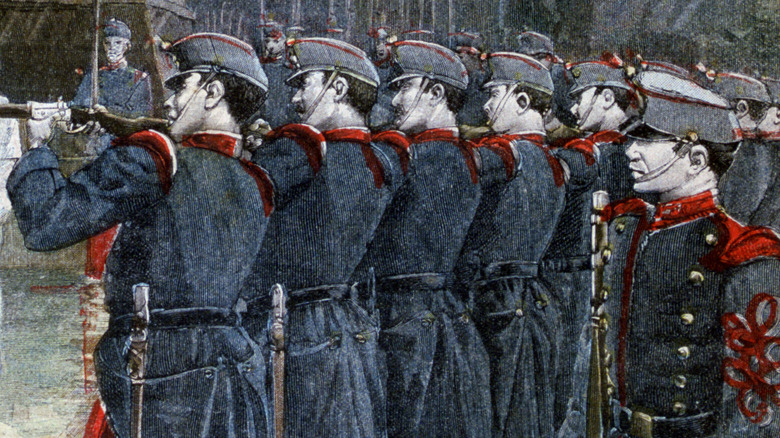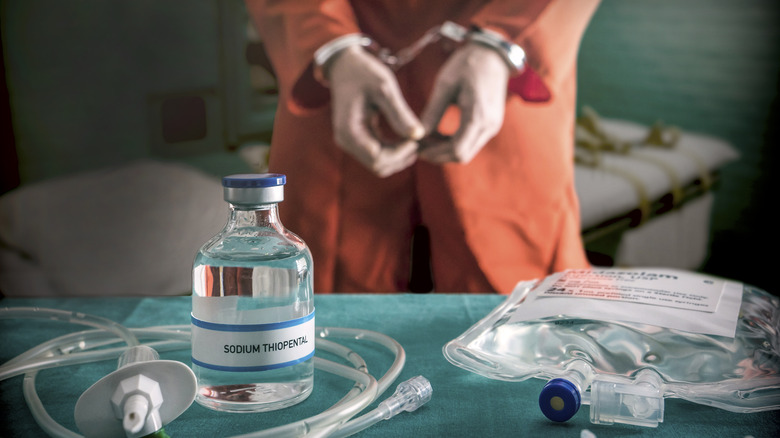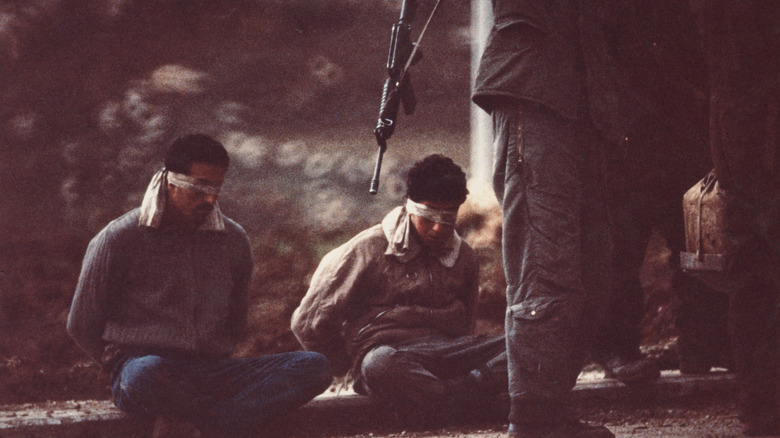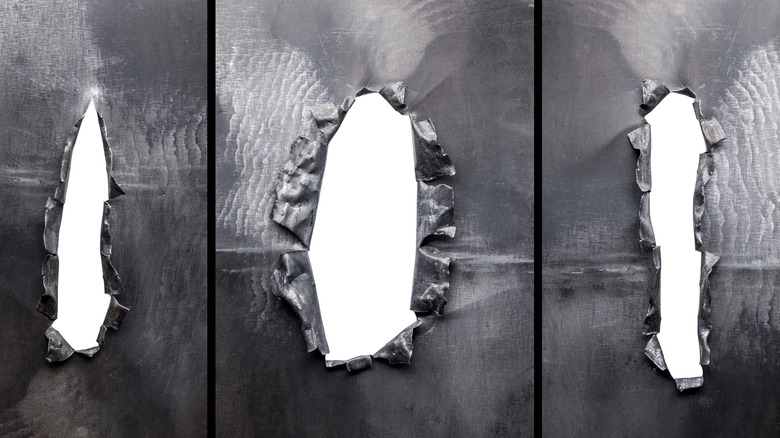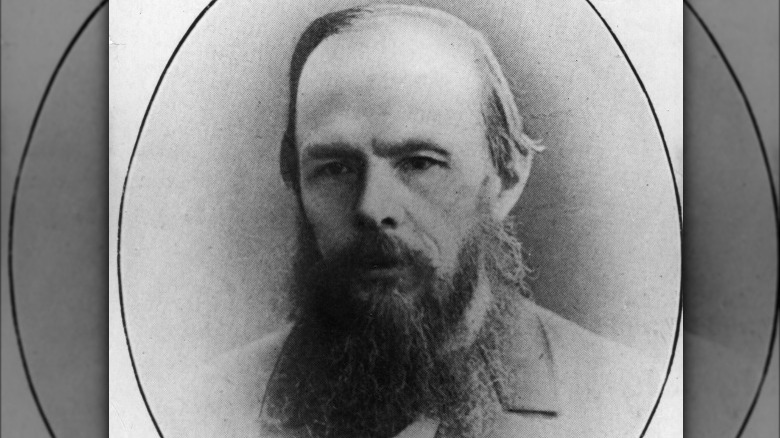What It's Like To Be Executed By A Firing Squad
The firing squad is back, according to a March of 2022 press release by the Department of Corrections of the state of South Carolina. The primary means of execution in South Carolina remains the electric chair; however, the condemned can also choose lethal injection or death by gunshot if they wish.
The press release detailed the state's newest accommodations. In the same room as the state's electric chair, but in a different corner, sits a chair with restraints for the condemned, 15 feet (4.5 meters) from a wall. This wall has a slot for three rifleman to aim through. The witness box has been refitted with bulletproof glass, presumably in case of ricochet, but neither the rifles nor the rifleman will be visible to witnesses. (Nor to the condemned, who will be hooded.) After the order to shoot, a doctor will enter the chamber to pronounce the prisoner dead; then a curtain will be drawn — a macabre theatrical flourish — and the witnesses will be escorted out.
More humane than other ways?
South Carolina joined only three American states that execute prisoners by gunshot — Mississippi, Oklahoma, and Utah, according to The Washington Post. There were two reasons for the change. One was practical: The drugs necessary for lethal injection are hard to get, and South Carolina had gone 10 years without carrying out scheduled executions for lack of resources. The second reason, cited by the Post, is that as brutal as getting shot in the chest may be, it's more humane than the alternative.
Is that true? Well, you can actually survive a lethal injection or the electric chair. It's rare, but it does happen, and then the condemned must be re-executed, a bitter farce for everyone involved. but according to Death Penalty Info, no botched death by firing squad has ever been recorded in the United States. No one survives three bullets to the heart at 15 feet.
Additionally, execution by firing squad may be a relatively painless death. Lethal injection was first proposed as a painless death, but it can be brutal, according to NPR — a kind of drowning as the lungs fill with fluid, before the heart stops beating. A sedative administered with the poisons is supposed to keep the condemned from feeling this, but no one can really say what the condemned feel. There have certainly been cases of prisoners showing signs of pain during the procedure.
Lights out
The question of whether three bullets to the heart are more or less humane than two syringes of poison does not break down along left-right political lines. Supreme Court Justice Sonia Sotomayor, often regarded as a liberal, has called the firing squad "comparatively painless." "Condemned prisoners," she wrote in an opinion, "might find more dignity in an instantaneous death rather than prolonged torture on a medical gurney" (per FiveThirtyEight).
There isn't much data available on how instantaneous death by firing squad is. Footage of the event seems to back up Justice Sotomayor. Judge for yourself. When fascism finally fell in Italy, the postwar government filmed the execution by firing squad of several fascist higher-ups, to be played in movie theater newsreels. Many of these films are available online. Be warned: these videos depict violent death. But if you can stomach them, you'll see that the condemned slumps over immediately on being shot, without the least sign of struggle or pain.
Death by gunshot
Everyone knows that death by gunshot is a grim affair; what people don't realize is how varied and unpredictable such a death can be. A trauma surgeon told The Trace, for example, that death resulting from a gunshot to the heart can take "minutes." Of course, there are gunshots to the heart and gunshots to the head; the patients in a New York City emergency room, even the ones recently shot, were probably not shot by a team of police marksmen at close range. Still, there's no guarantee that most wounds will kill a patient within a fixed timetable.
It's also not set in stone that a serious gunshot to the head or heart will prove fatal. The Trace describes that process of emergency thoracotomy, a protocol specifically made for patients whose hearts have stopped beating. Does it work? Less than 10% of the time, says the doctor interviewed by The Trace. But still, 9% of them make it, which is more than most people would have guessed.
History against a wall
Death by firing squad is much older than firearms. The early Christian martyr St. Sebastian (depicted above by the painter Guercino in 1642) was said to have been executed by a squad of archers during the reign of the Roman emperor Diocletian (via Franciscan Media).
When guns replaced bows in warfare, death by firing squad became an increasingly common punishment meted out by armies. This included the killing of civilians by soldiers, as the Spanish painter Goya recorded in his iconic painting, "Third of May 1808" (via Museo del Prado). Since then, a number of famous leaders met their end against a wall. Joachim Murat, the cavalry general who Napoleon made king of Naples, was shot under the wall of Pizzo Castle by British soldiers; famously vain, he is said to have told them to aim for the heart and spare his handsome face (via Italy On This Day). Maximilian I, Emperor of Mexico for three years, was overthrown by a popular liberal revolution. He faced a firing squad in 1867 (or did he?). Che Guevara, adventurer and apostle of revolution, apparently taunted the men lining up to kill him, calling them cowards (per The Nation).
The fake firing squad
One of the sadistic variations of the firing squad execution is the mock execution. First, the condemned is told that they will be executed. The condemned is duly blindfolded or handcuffed and led to a wall. The riflemen line up; the order to fire is given; but either no one shoots, or else they shoot blanks. The "condemned" then is led away, to undergo interrogation or suffer alone. Rare Historical Photos, which published a photo of a French Resistance guerrilla smiling at a Nazi firing squad seconds before his mock execution, calls the ordeal a "psychological trauma [that] results in permanent damage equivalent to the aftermath of physical torture."
The most famous victim of a mock firing squad was the Russian novelist Fyodor Dostoevsky (pictured). Accused of associating with dangerous radicals, Dostoevsky was arrested in 1849 and sentenced to death. They were led out of their cells and lined up. Little did they know it was all staged: an "unexpected" messenger burst onto the scene at the last minute to inform the prisoners that their sentence had been commuted (to hard labor in Siberia).
Capital punishment is as polarizing as an issue as they come. Nevertheless, everyone should be grateful that South Carolina has only legalized execution by firing squad, and not mock execution.
